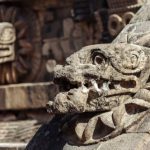 Creepy
Creepy  Creepy
Creepy  Technology
Technology 10 Scientific Breakthroughs of 2025 That’ll Change Everything
 Our World
Our World 10 Ways Icelandic Culture Makes Other Countries Look Boring
 Misconceptions
Misconceptions 10 Common Misconceptions About the Victorian Era
 Mysteries
Mysteries 10 Strange Unexplained Mysteries of 2025
 Miscellaneous
Miscellaneous 10 of History’s Most Bell-Ringing Finishing Moves
 History
History 10 Great Escapes That Ended Right Back in Captivity
 Weird Stuff
Weird Stuff 10 Fascinating Things You Might Not Know About Spiders
 Food
Food 10 Everyday Foods You Didn’t Know Were Invented by the U.S. Military
 History
History 10 Odd Things Colonial Americans Kept at Home
 Creepy
Creepy 10 More Representations of Death from Myth, Legend, and Folktale
 Technology
Technology 10 Scientific Breakthroughs of 2025 That’ll Change Everything
 Our World
Our World 10 Ways Icelandic Culture Makes Other Countries Look Boring
Who's Behind Listverse?

Jamie Frater
Head Editor
Jamie founded Listverse due to an insatiable desire to share fascinating, obscure, and bizarre facts. He has been a guest speaker on numerous national radio and television stations and is a five time published author.
More About Us Misconceptions
Misconceptions 10 Common Misconceptions About the Victorian Era
 Mysteries
Mysteries 10 Strange Unexplained Mysteries of 2025
 Miscellaneous
Miscellaneous 10 of History’s Most Bell-Ringing Finishing Moves
 History
History 10 Great Escapes That Ended Right Back in Captivity
 Weird Stuff
Weird Stuff 10 Fascinating Things You Might Not Know About Spiders
 Food
Food 10 Everyday Foods You Didn’t Know Were Invented by the U.S. Military
 History
History 10 Odd Things Colonial Americans Kept at Home
10 Unique Ancient Peoples Whose Cultural Footprints Still Shape the World
History has a funny way of remembering the loudest voices—the emperors, conquerors, and generals whose names echo through textbooks and tourist guides. But for every Caesar or Alexander, countless quieter civilizations shaped the world we live in today. Their contributions hide in plain sight, etched into our laws, our languages, our festivals, and even the buildings we walk past without a second thought.
These societies never built empires on Rome’s scale, yet their ideas spread like ripples in a pond, influencing cultures centuries after they vanished. From the artisans of the Andes who inspired legends of gold to desert merchants whose innovations allowed cities to flourish in the harshest climates, their fingerprints are everywhere—if you know where to look.
This list uncovers ten such obscure ancient peoples—forgotten by most, studied by few, but whose legacies quietly persist, shaping the way we live, work, and even think. Prepare to journey into the shadows of history, where the overlooked often wielded the most surprising influence.
Related: 10 Ways People Reacted When They Thought the World Was Ending
10 The Etruscans – Rome’s Hidden Architects
When you think of ancient Italy, Rome usually hogs the spotlight. But before the Romans built their empire, there were the Etruscans—an enigmatic civilization that thrived in central Italy from roughly 900 to 300 BC. They weren’t just neighbors to early Rome; they were teachers, trendsetters, and sometimes fierce rivals. The Etruscans introduced Rome to sophisticated urban planning, advanced engineering, and religious rituals that would later shape Roman society. Roads, drainage systems, and even the iconic triumphal arch were likely Etruscan in origin. And those gladiatorial games? They probably evolved from Etruscan funerary rites.
Their influence extended beyond infrastructure. Symbols of power like the fasces—a bundle of rods with an axe—originated with the Etruscans and later became emblems of Roman authority and Western iconography. Though gradually absorbed into Rome, their art, language, and religious practices lingered like echoes in the walls of Roman temples and tomb frescoes. Essentially, the Etruscans quietly laid the groundwork for one of history’s most famous civilizations, even if most people today wouldn’t recognize their name at a trivia night.[1]
9 The Sogdians – The Forgotten Merchants Who Connected the World
Before global trade had acronyms like WTO or NAFTA, there were the Sogdians—Central Asia’s original business class. Flourishing between the 4th and 10th centuries CE, these Persian-speaking merchants turned the Silk Road into the ancient world’s superhighway. From China to Byzantium, their caravans carried silk, spices, glassware, and gossip with equal efficiency. They didn’t conquer with swords but with contracts, becoming the indispensable middlemen between East and West.
Sogdian cities such as Samarkand and Bukhara became cosmopolitan melting pots long before the term existed—bustling with Persians, Indians, Chinese, and Arabs trading ideas as much as goods. Through Sogdian networks, Buddhism spread from India to China, and later, Manichaeism and Islam followed similar routes. Their language even became the unofficial tongue of trade across Central Asia.
Eventually, the Sogdians were absorbed by larger empires, their cities fading into dust and legend. But their spirit of cross-cultural exchange laid the groundwork for globalization itself. The world’s obsession with trade, travel, and cultural fusion? You can thank the Sogdians for getting that caravan rolling.[2]
8 The Minoans – The Seafarers Who Taught Europe to Dream
Long before Greece gave us gods and geometry, the island of Crete was home to the Minoans—a civilization so advanced it made its Bronze Age neighbors look primitive. Thriving between 2000 and 1400 BCE, the Minoans built sprawling palaces with plumbing, multistory architecture, and frescoes so vibrant they seem alive even today. Their palatial center at Knossos wasn’t just a city—it was an architectural masterpiece, complete with storerooms, workshops, and winding corridors that may have inspired the myth of the Minotaur’s labyrinth.
But their real genius was at sea. The Minoans ruled the Aegean through trade rather than warfare, exchanging olive oil, wine, and ceramics across the Mediterranean. Their ships became floating emissaries of culture, spreading ideas that would later shape the Greek world—from artistic styles to maritime navigation. Even the word “Europe” is commonly linked to their mythology.
Then, around 1450 BC, nature intervened. A cataclysmic volcanic eruption—likely Thera (modern Santorini)—devastated their society and contributed to its decline. Yet echoes of their sophistication survived, seeding the very foundations of European civilization.[3]
7 The Olmecs – The Civilization That Invented Civilization (in the Americas)
Before the Maya built their temples or the Aztecs sacrificed their enemies, there were the Olmecs—the mysterious “mother culture” of Mesoamerica. Flourishing along the Gulf Coast of modern Mexico between about 1200 and 400 BC, the Olmecs were doing “advanced civilization” before it was cool. They built cities with ceremonial centers, complex hierarchies, and—most famously—those colossal stone heads that still baffle archaeologists. Many of them weigh tens of tons and may represent ancient rulers or athletes.
The Olmecs also pioneered innovations that became cultural cornerstones across Central America. They may have developed an early writing system, used sophisticated calendars, and played the first version of the Mesoamerican ballgame—a ritual blend of politics, religion, and sport. Their influence spread far and wide, shaping the Maya, Zapotec, and Aztec civilizations that followed.
Despite their disappearance more than two millennia ago, the Olmecs left a legacy carved in basalt and embedded in belief. Every pyramid, every hieroglyph, and every rubber ball that bounced through Mesoamerican history carries an echo of the people who started it all.[4]
6 The Scythians – The Tattooed Horse Lords of the Steppe
If Attila the Hun was the thunder, the Scythians were the storm that came before. Long before the Mongols thundered across Asia, the Scythians ruled the vast Eurasian steppe between about 900 and 200 BC with deadly grace. They were nomads—archers, horsemen, and artists—who treated warfare as both survival and performance art. Herodotus described them as fierce warriors who drank the blood of their enemies, though that’s likely more myth than fact. In truth, they were sophisticated, mobile societies that mastered mounted combat centuries ahead of others.
Their golden artifacts—intricately crafted jewelry and weaponry—reveal a people obsessed with beauty as much as battle. Archaeologists have uncovered mummified Scythians adorned with elaborate tattoos that wouldn’t look out of place today. Their equestrian culture spread west into Europe and east into China, influencing warfare, art, and even fashion (those fitted riding trousers? Thank the Scythians).
Eventually, they vanished into the swirl of history, absorbed by the empires they once terrified. But their restless spirit—bold, free, and untamed—still gallops through every tale of the wandering warrior.[5]
5 The Hittites – The Empire That Invented Peace (Sort of)
While the ancient world perfected the art of conquest, the Hittites quietly pulled off something far more radical: diplomacy. Centered in modern-day Turkey, this Bronze Age power rose around 1600 BC, building an empire that rivaled Egypt and Babylon. The Hittites were master bureaucrats and early workers of iron—though its military use came later. Their true genius, however, wasn’t on the battlefield; it was at the negotiating table.
After years of conflict with Pharaoh Ramesses II, King Hattusili III did something no one expected—he signed a peace treaty. The Treaty of Kadesh (c. 1259 BC) is the oldest surviving international agreement in history, carved in cuneiform and still studied by political scientists today. It even included a mutual defense clause—Bronze Age NATO, if you will.
The Hittites codified legal systems, influenced neighboring religions, and established precedents for diplomacy that echo through modern statecraft. Though their empire eventually collapsed, their idea that words could end wars was, in its time, revolutionary.[6]
4 The Nabataeans – The Desert Engineers Who Outsmarted Nature
Imagine building a thriving metropolis in one of the driest deserts on Earth—without modern plumbing or electricity. The Nabataeans did exactly that. Flourishing between the 4th century BC and AD 106, these Arabian traders carved out an empire across the sands of modern Jordan, Syria, and Saudi Arabia. Their crowning achievement was Petra, a breathtaking city sculpted directly into rose-red cliffs—proof that even in the desert, art and ingenuity could bloom.
But Petra was more than a pretty façade. The Nabataeans were architectural and hydrological masterminds, engineering intricate systems of cisterns, canals, and ceramic pipelines that captured and stored every drop of rainfall. Control over water meant control over trade, and soon they dominated the incense and spice routes linking Arabia to the Mediterranean.
Though eventually absorbed into the Roman Empire, the Nabataeans’ ornate style—blending Greek, Egyptian, and local influences—inspired architects for centuries. Today, Petra stands not just as a tourist magnet but as a reminder that intelligence and innovation can turn even the harshest desert into a jewel of civilization.[7]
3 The Jomon – Japan’s Prehistoric Pottery Pioneers
Long before samurai or emperors, Japan was home to the Jomon people—hunter-gatherers who lived from roughly 14,000 to 300 BC. You might picture prehistoric life as a blur of caves and sticks, but the Jomon were surprisingly sophisticated. They crafted some of the world’s oldest known pottery, decorated with intricate cord-marked patterns that look like ancient graffiti art. Pottery allowed them to store and cook food, supporting a semi-sedentary lifestyle while much of humanity still roamed.
Their creativity didn’t stop at pots. The Jomon built pit houses, tended small gardens, and created clay figurines called dogu, often interpreted as spiritual or ritual objects. Some scholars see in them early expressions of religion or social structure—humans thinking symbolically long before cities or kings.
Though they left no written records, the Jomon laid cultural foundations that persist in Japan today. Their pottery influenced later craftsmanship, and their reverence for nature resonates in Shinto traditions. The Jomon were quietly shaping Japanese culture millennia before history started taking notes.[8]
2 The Phoenicians – The Traders Who Taught Humanity to Write
If civilization had a customer service department, the Phoenicians would’ve been running it. These ancient seafarers, from the narrow strip of land now called Lebanon, didn’t bother with sprawling empires or colossal monuments. Instead, they built something far more enduring: networks. Between about 1500 and 300 BC, the Phoenicians turned the Mediterranean into their personal trade route, ferrying timber, glass, and purple dye—once worth more than gold—and inventing a brand-new way to communicate: the alphabet.
Before them, writing systems were messy collections of thousands of symbols. The Phoenicians streamlined communication into a phonetic script of just 22 characters, each representing a sound. That idea spread like wildfire, eventually evolving into the Greek, Latin, and modern alphabets we use today.
They also founded colonies across the Mediterranean, most famously Carthage, which later became Rome’s greatest rival. Yet for all their influence, the Phoenicians left behind few words of their own. Ironically, the people who taught the world to write remain largely silent in the historical record.[9]
1 The Ainu People – Japan’s Forgotten Natives Who Refused to Vanish
Long before samurai, shoguns, and sushi, the northern islands of Japan were home to a resilient people known as the Ainu. With their thick beards, lighter skin, and distinct language, the Ainu were culturally different from the Japanese, who later dominated the archipelago. For centuries, they lived close to nature—fishing salmon from icy rivers, hunting bears in elaborate rituals, and honoring spirits (kamuy) believed to inhabit every stone, stream, and creature.
As Japanese influence expanded northward from the late medieval period, intensifying in the early modern era, the Ainu were gradually displaced. By the 1800s, they had lost much of their land and autonomy. The government banned their language and forced assimilation—but the Ainu never disappeared. In 2019, Japan passed a landmark law formally recognizing them as an Indigenous people, sparking a renewed cultural revival.
Today, Ainu traditions are being reclaimed through art, language schools, and heritage centers. Their survival story isn’t just about resistance—it’s about resilience. The Ainu remind us that even when history tries to write you out, identity has a way of writing itself back in.[10]








